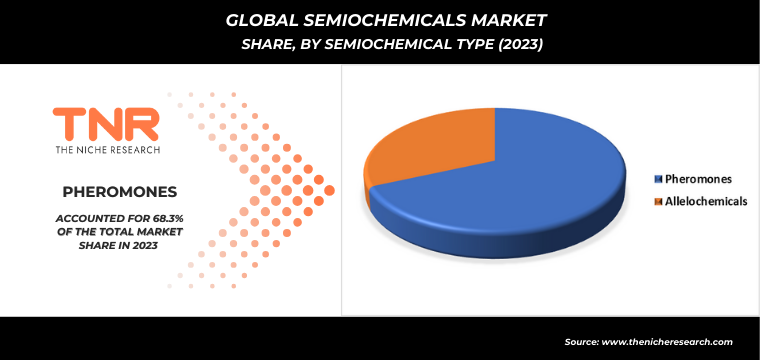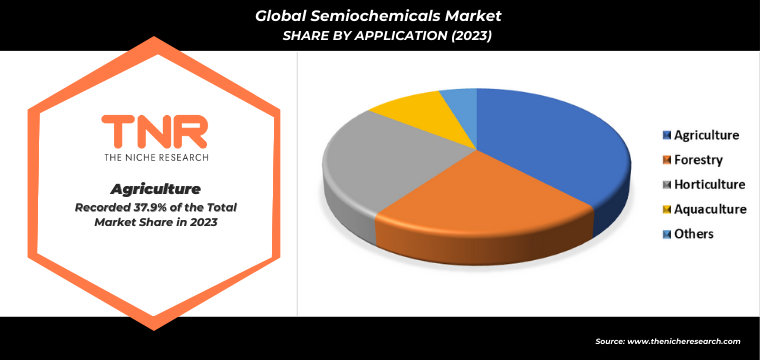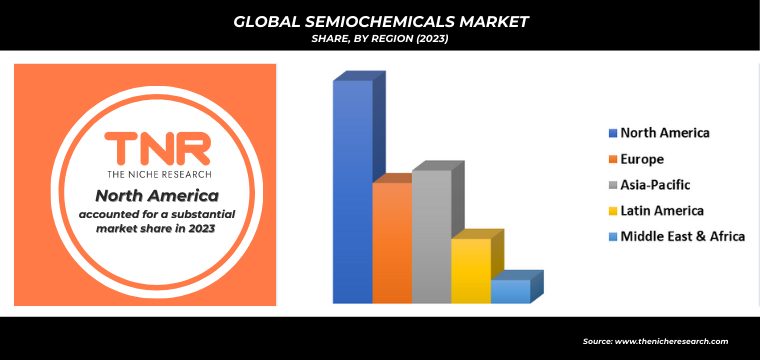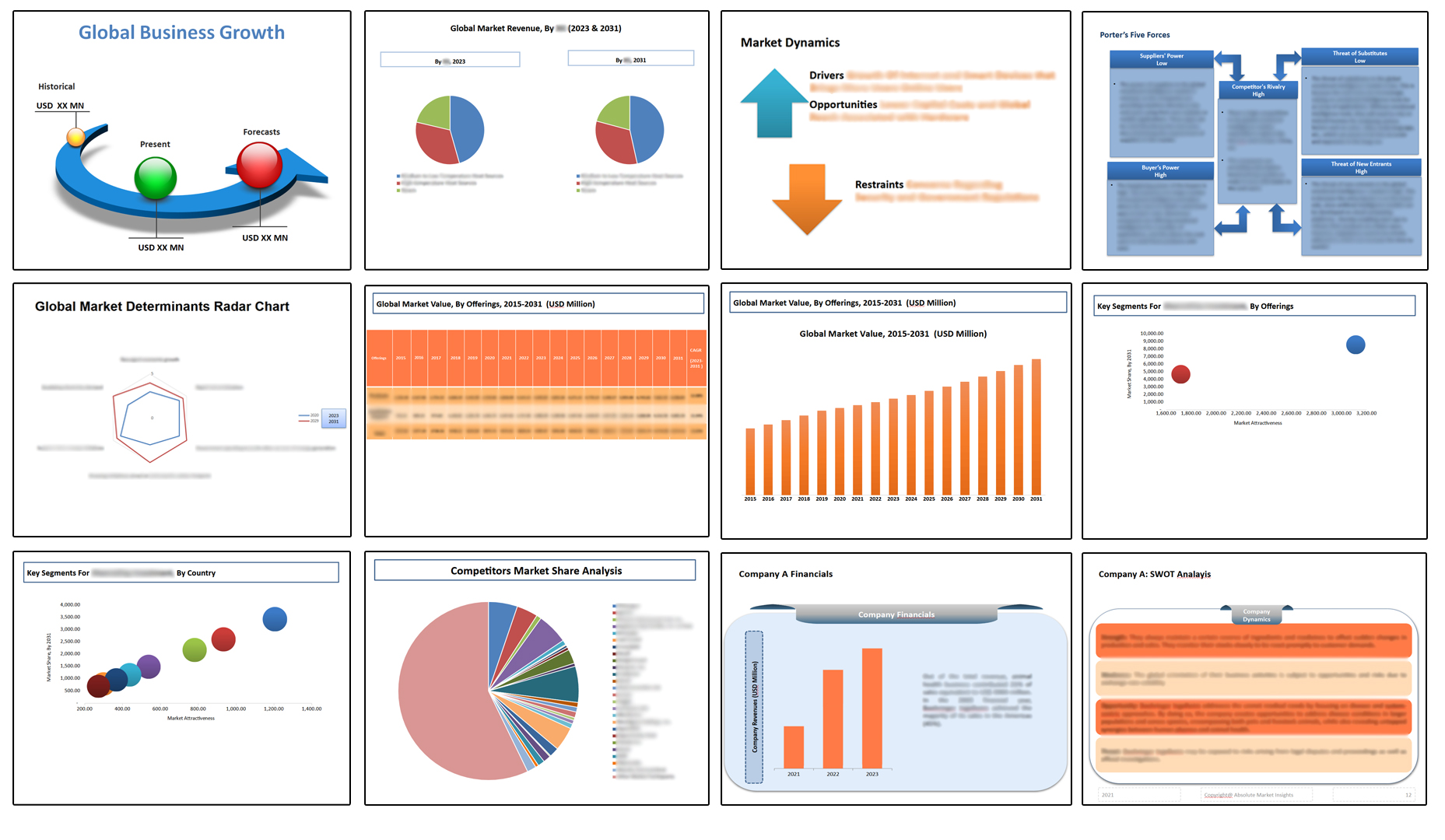Global Semiochemicals Market, By Semiochemical Type, By Application, By Region & Segmental Insights Trends and Forecast, 2024 – 2034
- Industry: Agriculture
- Report ID: TNR-110-1223
- Number of Pages: 420
- Table/Charts : Yes
- July, 2024
- Base Year : 2024
- No. of Companies : 10+
- No. of Countries : 29
- Views : 10219
- Covid Impact Covered: Yes
- War Impact Covered: Yes
- Formats : PDF, Excel, PPT
Semiochemicals are chemical substances or mixtures that convey information between organisms, triggering a variety of behavioural or physiological responses. The term is derived from the Greek word “semeion,” meaning signal, combined with “chemicals.” These compounds play a crucial role in the communication systems of many organisms, from insects to plants and even humans. Semiochemicals are primarily used in the study of chemical ecology, pest management, and agriculture.
The semiochemicals market is experiencing significant growth, driven by the increasing demand for environmentally sustainable pest management solutions. Rising concerns about the adverse effects of chemical pesticides on health and ecosystems are propelling the adoption of semiochemicals. Key growth drivers include advancements in biotechnology and increased funding for integrated pest management (IPM) programs. The market presents lucrative opportunities in agriculture, forestry, and public health sectors, particularly in developing regions with expanding agricultural activities.
Enhanced regulatory support and growing awareness about the benefits of semiochemicals are further fostering market expansion. As a result, the semiochemicals market is poised for robust growth, offering innovative and sustainable solutions for pest control and crop protection. In Terms of Revenue, the Global Semiochemicals Market was Worth US$ 5.2 Bn in 2023, Anticipated to Witness CAGR of 15.8% During 2024 – 2034.

Trends in the Global Semiochemicals Market
- Increasing Adoption of Integrated Pest Management (IPM): IPM emphasizes sustainable, environmentally friendly pest control methods, integrating biological controls, habitat manipulation, and the use of semiochemicals like pheromones and allelochemicals. This approach reduces reliance on synthetic pesticides, minimizing ecological damage and promoting biodiversity. Regulatory bodies worldwide are endorsing IPM practices, providing incentives and support for farmers and agricultural businesses. As awareness of the environmental and health benefits of IPM grows, the demand for semiochemicals is expected to surge, driving market growth and innovation in semiochemical formulations and delivery systems.
- Technological Advancements and Innovation: Developments in biotechnology and chemical engineering have enabled the synthesis of more stable and potent semiochemicals. New delivery systems, such as controlled-release dispensers and microencapsulation, enhance the effectiveness and longevity of semiochemicals in the field. These innovations reduce the frequency of applications and lower operational costs for users. Additionally, digital tools and precision agriculture technologies are being integrated with semiochemical applications, allowing for targeted pest control and real-time monitoring. This trend is expected to boost the efficacy and adoption of semiochemicals across various sectors.
In 2023, allelochemicals segment by semiochemical type category has emerged as the second-largest leading segment in the global semiochemicals market. This growth is driven by the rising need for sustainable agricultural practices and enhanced crop protection solutions. Allelochemicals, which facilitate interspecies communication, play a crucial role in natural pest control by deterring herbivores and attracting beneficial organisms. Their eco-friendly nature and specificity offer a significant advantage over traditional pesticides, reducing environmental impact and promoting soil health. The segment’s expansion is further supported by advancements in biotechnology, enabling the production of more effective and stable allelochemical formulations. Increased regulatory support and awareness of sustainable farming practices are expected to continue driving the demand for allelochemicals.

By application, agriculture segment dominated the global semiochemicals market and is expanding with a CAGR of 11.7% over the forecast timeline. This growth is fueled by the increasing adoption of sustainable farming practices and the rising need for effective pest management solutions. Semiochemicals, such as pheromones and allelochemicals, offer targeted and environmentally friendly alternatives to conventional pesticides, reducing chemical residues in crops and soil. Enhanced regulatory support and growing awareness about the benefits of integrated pest management (IPM) are also driving market expansion. Technological advancements in semiochemical formulations and delivery systems further bolster their efficacy and adoption. As global agricultural activities intensify, the demand for semiochemicals in crop protection and yield enhancement is set to soar.

In 2023, Asia Pacific is anticipated to solidified its position as the leading region in the semiochemicals market, driven by rapid agricultural expansion and increasing adoption of sustainable farming practices. The region’s vast and diverse agricultural landscape necessitates efficient pest management solutions, propelling the demand for semiochemicals. Governments across Asia Pacific are implementing favourable policies and offering incentives to promote integrated pest management (IPM) and reduce reliance on chemical pesticides. Additionally, advancements in biotechnology and increased research funding are contributing to the development of innovative semiochemical products. The growing awareness of the environmental and health benefits associated with semiochemicals further supports their widespread adoption, ensuring robust market growth in the Asia Pacific region.

Competitive Landscape
Some of the players operating in the semiochemicals market are
- BASF SE
- Bedoukian Research, Inc.
- Biobest Group NV
- International Pheromone Systems Ltd.
- Isagro Group
- Koppert Biological Systems
- Laboratorio Agrochem S.A.
- Marrone Bio Innovations, Inc.
- Novagrica
- Pherobank B.V.
- Russell IPM Ltd.
- SemiosBio Technologies Inc.
- Shin-Etsu Chemical Co., Ltd.
- Sumitomo Chemical Co., Ltd.
- Suterra LLC
- Syngenta AG
- Trécé Inc.
- Other Industry Participants
Global Semiochemicals Market Scope
| Report Specifications | Details |
| Market Revenue in 2023 | US$ 5.2 Bn |
| Market Size Forecast by 2034 | US$ 26.1 Bn |
| Growth Rate (CAGR) | 15.8% |
| Historic Data | 2016 – 2022 |
| Base Year for Estimation | 2023 |
| Forecast Period | 2024 – 2034 |
| Report Inclusions | Market Size & Estimates, Market Dynamics, Competitive Scenario, Trends, Growth Factors, Market Determinants, Key Investment Segmentation, Product/Service/Solutions Benchmarking |
| Segments Covered | By Semiochemical Type, By Application, By Region |
| Regions Covered | North America, Europe, Asia Pacific, Middle East & Africa, Latin America |
| Countries Covered | U.S., Canada, Mexico, Rest of North America, France, The UK, Spain, Germany, Italy, Nordic Countries (Denmark, Finland, Iceland, Sweden, Norway), Benelux Union (Belgium, The Netherlands, Luxembourg), Rest of Europe, China, Japan, India, New Zealand, Australia, South Korea, Southeast Asia (Indonesia, Thailand, Malaysia, Singapore, Rest of Southeast Asia), Rest of Asia Pacific, Saudi Arabia, UAE, Egypt, Kuwait, South Africa, Rest of Middle East & Africa, Brazil, Argentina, Rest of Latin America |
| Key Players | BASF SE, Bedoukian Research, Inc., Biobest Group NV, International Pheromone Systems Ltd., Isagro Group, Koppert Biological Systems, Laboratorio Agrochem S.A., Marrone Bio Innovations, Inc., Novagrica, Pherobank B.V., Russell IPM Ltd., SemiosBio Technologies Inc., Shin-Etsu Chemical Co., Ltd., Sumitomo Chemical Co., Ltd., Suterra LLC, Syngenta AG, Trécé Inc. |
| Customization Scope | Customization allows for the inclusion/modification of content pertaining to geographical regions, countries, and specific market segments. |
| Pricing & Procurement Options | Explore purchase options tailored to your specific research requirements |
| Contact Details | Consult With Our Expert
Japan (Toll-Free): +81 663-386-8111 South Korea (Toll-Free): +82-808- 703-126 Saudi Arabia (Toll-Free): +966 800-850-1643 United Kingdom: +44 753-710-5080 United States: +1 302-232-5106 E-mail: askanexpert@thenicheresearch.com
|
Global Semiochemicals Market
By Semiochemical Type
- Pheromones
- Sex Pheromones
- Aggregation Pheromones
- Trail Pheromones
- Others
- Allelochemicals
- Allomones
- Kairomones
- Synomones
By Application
- Agriculture
- Forestry
- Horticulture
- Aquaculture
- Others
By Region
- North America (U.S., Canada, Mexico, Rest of North America)
- Europe (France, The UK, Spain, Germany, Italy, Nordic Countries (Denmark, Finland, Iceland, Sweden, Norway), Benelux Union (Belgium, The Netherlands, Luxembourg), Rest of Europe)
- Asia Pacific (China, Japan, India, New Zealand, Australia, South Korea, Southeast Asia (Indonesia, Thailand, Malaysia, Singapore, Rest of Southeast Asia), Rest of Asia Pacific)
- Middle East & Africa (Saudi Arabia, UAE, Egypt, Kuwait, South Africa, Rest of Middle East & Africa)
- Latin America (Brazil, Argentina, Rest of Latin America)
Report Layout:

Table of Contents
Note: This ToC is tentative and can be changed according to the research study conducted during the course of report completion.
**Exclusive for Multi-User and Enterprise User.
Global Semiochemicals Market
By Semiochemical Type
- Pheromones
- Sex Pheromones
- Aggregation Pheromones
- Trail Pheromones
- Others
- Allelochemicals
- Allomones
- Kairomones
- Synomones
By Application
- Agriculture
- Forestry
- Horticulture
- Aquaculture
- Others
By Region
- North America (U.S., Canada, Mexico, Rest of North America)
- Europe (France, The UK, Spain, Germany, Italy, Nordic Countries (Denmark, Finland, Iceland, Sweden, Norway), Benelux Union (Belgium, The Netherlands, Luxembourg), Rest of Europe)
- Asia Pacific (China, Japan, India, New Zealand, Australia, South Korea, Southeast Asia (Indonesia, Thailand, Malaysia, Singapore, Rest of Southeast Asia), Rest of Asia Pacific)
- Middle East & Africa (Saudi Arabia, UAE, Egypt, Kuwait, South Africa, Rest of Middle East & Africa)
- Latin America (Brazil, Argentina, Rest of Latin America)
The Niche Research approach encompasses both primary and secondary research methods to provide comprehensive insights. While primary research is the cornerstone of our studies, we also incorporate secondary research sources such as company annual reports, premium industry databases, press releases, industry journals, and white papers.
Within our primary research, we actively engage with various industry stakeholders, conducting paid interviews and surveys. Our meticulous analysis extends to every market participant in major countries, allowing us to thoroughly examine their portfolios, calculate market shares, and segment revenues.
Our data collection primarily focuses on individual countries within our research scope, enabling us to estimate regional market sizes. Typically, we employ a bottom-up approach, meticulously tracking trends in different countries. We analyze growth drivers, constraints, technological innovations, and opportunities for each country, ultimately arriving at regional figures.Our process begins by examining the growth prospects of each country. Building upon these insights, we project growth and trends for the entire region. Finally, we utilize our proprietary model to refine estimations and forecasts.
Our data validation standards are integral to ensuring the reliability and accuracy of our research findings. Here’s a breakdown of our data validation processes and the stakeholders we engage with during our primary research:
- Supply Side Analysis: We initiate a supply side analysis by directly contacting market participants, through telephonic interviews and questionnaires containing both open-ended and close-ended questions. We gather information on their portfolios, segment revenues, developments, and growth strategies.
- Demand Side Analysis: To gain insights into adoption trends and consumer preferences, we reach out to target customers and users (non-vendors). This information forms a vital part of the qualitative analysis section of our reports, covering market dynamics, adoption trends, consumer behavior, spending patterns, and other related aspects.
- Consultant Insights: We tap into the expertise of our partner consultants from around the world to obtain their unique viewpoints and perspectives. Their insights contribute to a well-rounded understanding of the markets under investigation.
- In-House Validation: To ensure data accuracy and reliability, we conduct cross-validation of data points and information through our in-house team of consultants and utilize advanced data modeling tools for thorough verification.
The forecasts we provide are based on a comprehensive assessment of various factors, including:
- Market Trends and Past Performance (Last Five Years): We accurately analyze market trends and performance data from preceding five years to identify historical patterns and understand the market’s evolution.
- Historical Performance and Growth of Market Participants: We assess the historical performance and growth trajectories of key market participants. This analysis provides insights into the competitive landscape and individual company strategies.
- Market Determinants Impact Analysis (Next Eight Years): We conduct a rigorous analysis of the factors that are projected to influence the market over the next eight years. This includes assessing both internal and external determinants that can shape market dynamics.
- Drivers and Challenges for the Forecast Period:Identify the factors expected to drive market growth during the forecast period, as well as the challenges that the industry may face. This analysis aids in deriving an accurate growth rate projection.
- New Acquisitions, Collaborations, or Partnerships: We keep a close watch on any new acquisitions, collaborations, or partnerships within the industry. These developments can have a significant impact on market dynamics and competitiveness.
- Macro and Micro Factors Analysis:A thorough examination of both macro-level factors (e.g., economic trends, regulatory changes) and micro-level factors (e.g., technological advancements, consumer preferences) that may influence the market during the forecast period.
- End-User Sentiment Analysis: To understand the market from the end-user perspective, we conduct sentiment analysis. This involves assessing the sentiment, preferences, and feedback of the end-users, which can provide valuable insights into market trends.
- Perspective of Primary Participants: Insights gathered directly from primary research participants play a crucial role in shaping our forecasts. Their perspectives and experiences provide valuable qualitative data.
- Year-on-Year Growth Trend: We utilize a year-on-year growth trend based on historical market growth and expected future trends. This helps in formulating our growth projections, aligning them with the market’s historical performance.
Research process adopted by TNR involves multiple stages, including data collection, validation, quality checks, and presentation. It’s crucial that the data and information we provide add value to your existing market understanding and expertise. We have also established partnerships with business consulting, research, and survey organizations across regions and globally to collaborate on regional analysis and data validation, ensuring the highest level of accuracy and reliability in our reports.










